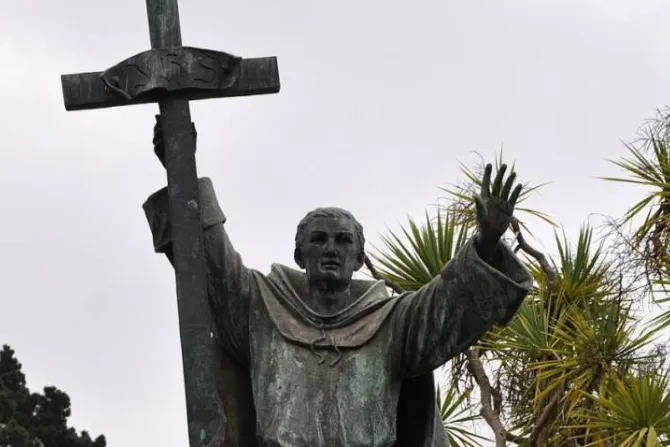Los Angeles, Calif., Sep 13, 2021 / 18:00 pm
Misinformation and deliberate disinformation continue to surround the memory of St. Junípero Serra, the Apostle of California.
Most recently, the California legislature overwhelmingly passed a bill that essentially declares Serra to be a kind of moral monster: “Enslavement of both adults and children, mutilation, genocide, and assault on women were all part of the mission period initiated and overseen by Father Serra.”
Assembly Bill 338, which passed 66–2 in the Assembly and 28–2 in the Senate, has been sent to Gov. Gavin Newsom. It repeats the unsubstantiated allegations found in online petitions and other misinformation spread last summer by Black Lives Matter and other activist groups to justify vandalizing statues of the saint in Los Angeles, San Francisco, and at the Capitol in Sacramento.
The legislature’s claims are a “slander” against Serra and push a “false narrative” about the missions, say Archbishop José H. Gomez and Archbishop Salvatore Cordileone of San Francisco in a new opinion essay published in the Wall Street Journal. “None of that is true,” they write. “While there is much to criticize from this period, no serious historian has ever made such outrageous claims about Serra or the mission system.”
Pope Francis canonized St. Junípero Serra personally in Washington, D.C. on September 23, 2015, the first-ever canonization on American soil.
It is rare for popes to celebrate canonizations outside of Rome. But Francis, an immigrant’s son and the first pontiff from the New World, emphasized Serra’s holiness, his historic significance as America’s first Hispanic saint, and called him “one of the founding fathers of the United States.”
Prior to the canonization, Pope Francis took part in a day-long symposium hosted by the Pontifical North American College and organized by the Knights of Columbus, that included presentations by Archbishop Gomez and top scholars from the United States.
St. Pope John Paul II, who beatified Serra in 1988, prayed at his tomb at Mission San Carlos Borroméo in Carmel, and praised his “heroic spirit and heroic deeds,” and called him a “defender and champion” of the indigenous Californians.
“Very often at crucial moments in human affairs,” the pope said, “God raises up men and women whom he thrusts into roles of decisive importance for the future development of both society and the Church. … So it is with Junípero Serra, who in the providence of God was destined to be the Apostle of California, and to have a permanent influence over the spiritual patrimony of this land and its people, whatever their religion might be.”
The best biographers of Serra and historians of California’s early history are Robert Senkewicz, Professor of History Emeritus at Santa Clara University and his wife, Rose Marie Beebe, Professor of Spanish Emerita at Santa Clara University.
Their book, “Junípero Serra: California, Indians, and the Transformation of a Missionary,” is the definitive academic study and includes original translations of Serra’s letters.
Beebe and Senkewicz were featured participants in the symposium on the legacy of St. Junípero Serra hosted by Pontifical North American College May 2, 2015.
The leading archeologist of the California missions is Rubén Mendoza, Professor of Archaeology and Social and Behavioral Sciences at the California State University, Monterey Bay. Mendoza, a Yaqui Indian and Mexican American, is a prolific author and has spoken movingly about his “conversion” on Serra, based on his academic research at the missions.
Mendoza discovered the so-called “Serra chapels” at the Royal Presidio of Monterey in 2008, the rectangular adobe buildings located directly in front of the present San Carlos Cathedral, built in the early 1790s. The Serra chapels mark the spot where, in 1770, St. Junípero celebrated the earliest Mass in a church on the California coast.
In addition, Mendoza’s research has discovered that Mission San Juan Bautista and at least 12 of the California missions were designed according to an ancient practice of enabling the sun to illuminate specific areas of the sanctuary during the winter or summer solstice.
Mendoza was a featured participant in the symposium on the legacy of St. Junípero Serra hosted by Pontifical North American College May 2, 2015.
(Story continues below)
Gregory Orfalea, a noted journalist and essayist, has written a fine biography, Journey to the Sun: Junipero Serra's Dream and the Founding of California, and an excellent book for students and families, Junipero Serra and the California Missions: A Family Guide.
A version of this article first appeared at Angelus News. It has been adapted and reprinted with permission.



